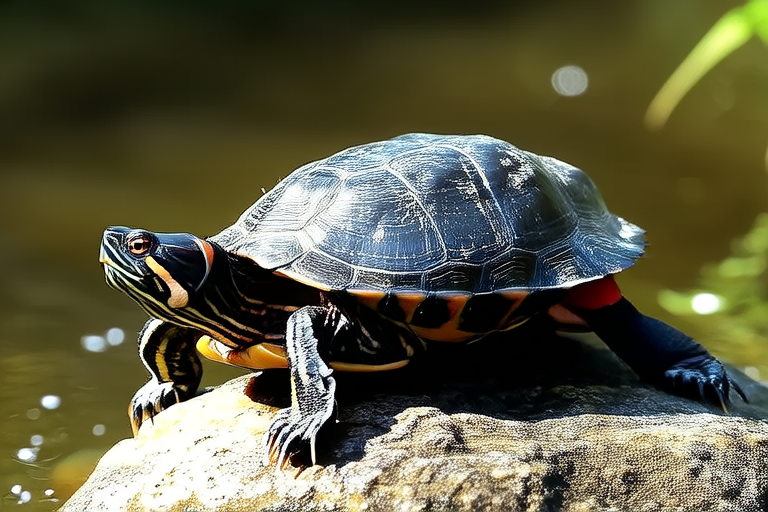Shell Shocked! Common Myths About Red-eared Sliders Debunked
The red-eared slider (Trachemys scripta elegans) is one of the most popular turtle species kept as pets worldwide. Their striking appearance, with their characteristic red stripes behind each eye, makes them attractive to many potential owners. However, despite their widespread appeal, there are numerous misconceptions about these reptiles that can lead to improper care and even harm to the turtles themselves. This article aims to debunk some of the most common myths surrounding red-eared sliders, providing scientifically-backed information to ensure responsible ownership.
Understanding Red-Eared Sliders
Red-eared sliders are semi-aquatic turtles native to North America, particularly in the Mississippi River Valley. They have adapted to live both on land and in water, requiring environments that mimic their natural habitats. As pets, they require specific conditions to thrive, including adequate space, appropriate lighting, and a balanced diet. Despite their popularity, many owners are unaware of the exact needs of these animals, leading to widespread myths and misinformation.
Myth 1: Red-eared Sliders Are Low-Maintenance Pets
Fact: One of the most pervasive myths about red-eared sliders is that they are easy to care for. While they may seem simple to maintain at first glance, these turtles actually require significant attention to their environment, diet, and health. Proper care involves setting up a suitable tank or pond, ensuring appropriate water temperature and filtration, and providing UVB lighting for vitamin D synthesis. Without these essential elements, red-eared sliders can suffer from a variety of health issues, such as shell rot, metabolic bone disease, and respiratory infections.
Myth 2: Red-eared Sliders Can Be Kept in Small Tanks
Fact: Another misconception is that red-eared sliders can be housed in small tanks or bowls. In reality, these turtles need ample space to swim and bask. A rule of thumb is to provide at least 10 gallons of water per inch of shell length for juvenile turtles, increasing to 40 gallons or more for adults. Insufficient space leads to stress, poor health, and stunted growth. Additionally, overcrowding can exacerbate hygiene issues and increase the risk of disease transmission.
Myth 3: Red-eared Sliders Only Need Water
Fact: Many believe that since red-eared sliders spend much of their time in water, they only need aquatic environments. However, these turtles also require dry land areas for basking. Basking is crucial for thermoregulation and drying off, preventing skin infections and promoting healthy shell growth. An ideal setup includes a shallow water area and a land area with a heat lamp emitting UVB radiation. Without proper basking conditions, turtles can develop shell deformities and other health problems.
Myth 4: Red-eared Sliders Eat Anything
Fact: Feeding red-eared sliders a varied diet is essential for their well-being. A common myth is that they will eat any food provided, but this is far from true. A balanced diet should consist primarily of commercial turtle pellets supplemented with fresh vegetables, fruits, and occasional protein sources like insects or fish. Overfeeding or feeding inappropriate foods can lead to obesity and nutritional deficiencies. It’s important to monitor portion sizes and avoid feeding them bread, junk food, or excessive amounts of animal protein.
Myth 5: Red-eared Sliders Have Short Lifespans
Fact: Contrary to popular belief, red-eared sliders can live for several decades when properly cared for. Lifespan estimates range from 20 to 40 years, with some individuals living even longer under optimal conditions. Factors influencing longevity include genetics, diet, environmental enrichment, and healthcare. Neglecting any of these aspects can significantly reduce a turtle’s lifespan. Regular veterinary check-ups, especially for signs of metabolic bone disease, are recommended to ensure long-term health.
Myth 6: Red-eared Sliders Are Disease-Free
Fact: Like all animals, red-eared sliders are susceptible to various diseases and parasites. One prevalent myth is that they don’t get sick easily. In fact, improper husbandry practices can make them vulnerable to illnesses such as shell rot, respiratory infections, and parasites. Regular cleaning of the enclosure, maintaining correct water parameters, and providing appropriate nutrition are vital to prevent health issues. Early detection and treatment by a veterinarian specializing in reptiles are key to managing any potential health problems.
Tips for Responsible Ownership
Adopting a red-eared slider comes with significant responsibilities. Here are some tips to ensure your turtle lives a long and healthy life:
- Research Thoroughly: Before bringing home a red-eared slider, learn about their specific needs and requirements. Understanding their biology and behavior helps you provide the best possible care.
- Set Up Appropriate Housing: Create an environment that mimics their natural habitat, including adequate water and land areas, proper lighting, and filtration systems.
- Feed a Balanced Diet: Provide a nutritious diet consisting of commercial pellets, vegetables, fruits, and occasional proteins. Avoid overfeeding and feeding inappropriate foods.
- Monitor Health Closely: Keep an eye out for any signs of illness, such as lethargy, loss of appetite, or abnormal behaviors. Schedule regular vet visits to catch potential issues early.
- Commit Long-Term: Red-eared sliders can live for decades, so consider the long-term commitment involved in owning one. Plan accordingly to ensure they receive consistent care throughout their lives.
By debunking these common myths and following the tips outlined above, you can become a responsible owner of red-eared sliders. Remember, while these turtles might seem simple to care for initially, they require dedicated attention and resources to thrive. Always prioritize your turtle’s health and well-being, and consult reputable sources or professionals if you have any doubts about their care.
In conclusion, red-eared sliders are fascinating creatures that deserve thoughtful consideration before adoption. By educating yourself and adhering to best practices, you can provide a loving home for these remarkable reptiles. Happy turtle keeping!
